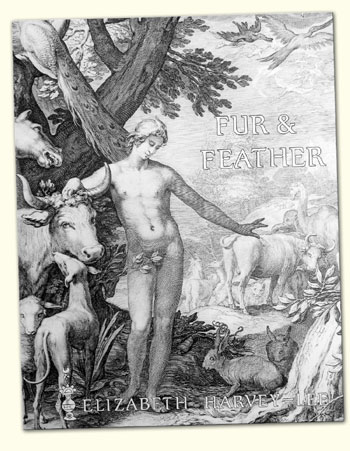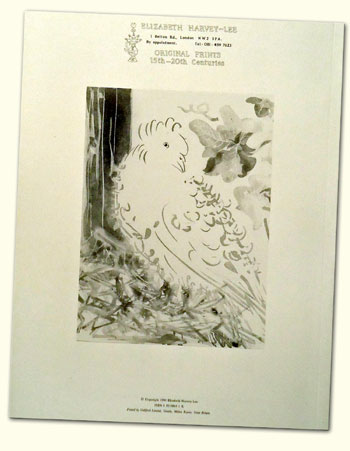|
FUR
& FEATHER
 Animals
thematic and incidental in print Animals
thematic and incidental in print
Mankind
has not changed physically in the last five hundred
years, but fashions in dress and hairstyle have altered
his visual appearance dramatically in art of different
periods. Animals, not affected by such external trappings,
have not changed greatly. The cat or dog discovered
in an early picture excites by its apparent modernity
and bridges the centuries as though timeless.
From
cave paintings through the earliest Western civilisations
of Mesopotamia, Egypt and Greece, animals are seen
to hold special, even religious significance for man.
By the 16th century, although animals had lost their
deistic importance, they retained symbolic associations.
The owl personified night and hence sleep and so appears
twice in Brueghel’s allegory of 'Idleness'. A
deer introduced into de Jode’s representation
of the sense of 'Hearing' alludes to the animals charmed
by the lyre of Apollo, god of music, on Mount Parnassus.
Jupiter appeared transformed in various animal guises
to further his amorous pursuits. St Jerome is identified
by the attribute of his attendant lion; St John the
Evangelist by an eagle. The Old Testament stories
of Adam and Noah allowed the artist full reign in the
delight of depicting the animal kingdom. The cat curled
up in the corner of Barocci’s 'Annunciation'
is an expression of human domesticity and has the added
charm of being no doubt the artist’s own cat,
as is perhaps the dog in Duplessis-Bertaux’s
'Engraver’s Studio'. In contrast, naturalistic
cattle and sheep in pastoral landscapes bathed in golden
light were the speciality of some of the Dutch 17th
century etchers.
The
scientific and encyclopaedic enthusiasm which led to
a blossoming of botanic prints in the 18th and 19th
centuries did not inspire many equivalent zoological
plates, with the notable exception of several fine
sets of bird prints. Zoological gardens instead supplied
artists with motifs for original printmaking that went
beyond simply an accurate record. Romantics like Delacroix
drew lions and tigers as similes of wild, untamed nature.
The Picturesque movement used animals as apposite ornamental
details in landscape.
 Whereas
old master prints tend to introduce animals incidentally,
in the modern period they are more often centre-stage.
Reflecting changes in patronage and a general move
away from established religion and classical education,
animals in modern prints are depicted for their own
sake or for their decorative qualities. Though perhaps
occasionally the artist may also have an eye to a good
commercial subject, few do not demonstrate a tenderness
in approach which has its own redeeming appeal. Artists
as diverse as Steinlen, Austin and Picasso beautifully
express the companionship of so-called dumb creation
in a way which speaks volumes. Whereas
old master prints tend to introduce animals incidentally,
in the modern period they are more often centre-stage.
Reflecting changes in patronage and a general move
away from established religion and classical education,
animals in modern prints are depicted for their own
sake or for their decorative qualities. Though perhaps
occasionally the artist may also have an eye to a good
commercial subject, few do not demonstrate a tenderness
in approach which has its own redeeming appeal. Artists
as diverse as Steinlen, Austin and Picasso beautifully
express the companionship of so-called dumb creation
in a way which speaks volumes.
This
selection of prints is not just a collection of pretty
pictures of cuddly (and some not so cuddly) animals.
Several of the prints are by the great masters of printmaking,
including Rembrandt and Goya. The English School is
well represented with works by Blake, Cotman, Crome,
Constable, Palmer, Blampied and Tunnicliffe. The fine
group of prints by Robert Austin spans his printmaking
activities from student days to maturity, and paralleling
his development from etcher to engraver. Equally the
theme has encouraged inclusion of some interesting
minor artists, rarely encountered. There are some scarcities
and a few rarities, and something of interest I hope
for everyone.
Published
1990.
48 pages, 142 prints described and illustrated in black
and white.
(UK Price: £7, International orders: £10)
^ Return to the top of this page ^ |
|
Artists
included in the catalogue:
- Anderson
S.
- Ansdell
R.
- Armfield
M.
- Auerbach
A.
- Austen
W.
- Austin
R.S.
- Bacon
P.
- Barocci
F.
- Beeh
R.
- Beham
S.
- Bella
S. della
- Benson
F.W.
- Berchem
N.
- Berthauld
H.
- Blake
W.
- Blampied
E.
- Bloemaert
A.
- Bloemaert
C.
- Bol
H.
- Bonasone
G.
- Boutet
H.
- Boyvin
R.
- Bresdin
R.
- Brightwell
L.R.
- Brouet
A.
- Brueghel
P.
- Bruyer
G.L.
- Bry
T. de
- Cain
C.W.
- Callot
J.
- Caspar
K.
- Chapin
F.
- Clayton
K.M.
- Constable
J.
- Cotman
J.S.
- Crépin
S.
- Crome
J.
- Daubigny
C.F.
- Daumier
H.
- Delacroix
E.
- Delaune
E.
- Derby
W.
- Detmold
E.J.
- Deutechum
J.
- Duplessis-Bertaux
J.
- Eberhardt
M.
- Flamen
A.
- Födransberg
A. von
- Fridell
A.
- Fyt
J.
- Gardier
R. du
- Gaul
A.
- Gawthorne
H.G.
- Gelin
L.
- Ghisi
A.
- Gill
E.
- Goeneutte
N.
- Goltzius
H.
- Goya
F.
- Grant
G.
- Greiner
O.
- Grossman
R.
- Hagemanns
M
- Hartley
A.
- Henderson
E.M.
- Heyden
P. van de
- Jode
P. de
- Karacz
I.
- Lambert
L.E.
- Lambert
T.H.
- La
Touche G.
- Leighton
C.
- Le
Prince J.B.
- Lucas
van Leyden
- Lucas
D.
- MacLaughlan
D.S.
- Maillol
A.
- Matham
J.
- Maurin
C.
- McEntee
D.
- Menpes
M.
- Meyer
H.
- Muyden
E. van
- Nash
J.
- Nicholson
W.
- Osborne
M.
- Palmer
S.
- Picasso
P.
- Platt
J.E.
- Plückebaum
M.
- Pott
C.M.
- Ranft
R.
- Rembrandt
- Roux
O.
- Saenredam
J.
- Schiamossi
R.
- Schrimpf
G.
- Seewald
R.
- Shannon
C.H.
- Slevogt
M.
- Steinlen
T.A.
- Stiles
S.
- Stoop
D.
- Thomson
L.
- Tunnicliffe
C.F.
- Underwood
L.
- Villon
J.
- Ward
L.
- Whistler
J.M.
- Wilkie
D.
- Wilson
S.R.
- Woollard
D.E.C.
- Wright
J.
Return to the top |